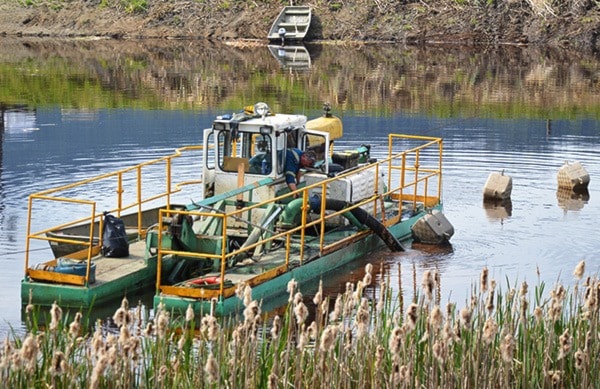Preparations have begun at the former Catalyst Paper sewage lagoon in order to get it ready for city usage.
“We’ve started dredging the lagoon to prepare for the switch,” said City of Port Alberni major projects advisor Ken Watson.
The city purchased Catalyst Paper’s former lagoon in 2011 at a cost of $5.7 million and has been working on the logistics of switching over ever since, with an estimated switch over date of 2018. At the time, the project was estimated to cost $14.5 million and the city received a $11.2 million federal government grant. The city was not allowed to use the grant to purchase the former Catalyst lagoon itself.
“We have been working with Associated Engineering to undertake the design of the facility as well as working through our liquid waste management plan to find out what all of the different issues stakeholders have about how we’re going to implement this process,” said Watson.
The dredging phase has now begun and the work has been contracted to Associated Engineering of Burnaby at a cost of $1.9 million.
“They have a boat that’s connected to a series of pipes and a pump. What it does is as it goes along the bottom of the lagoon it sucks up all of the sludge that has accumulated over say, 30 years,” said Associated Engineering wastewater engineer Jason Leong.
“The sludge will then be transported back where it’s first screened to remove all the big stuff and then sent to the centrifuges where it’s spun around and mixed with de-watering polymer.”
The polymer causes the solids to stick together and allows for easier separation of the solids.
The company will remove 4,400 bone dry tonnes or 880 trucks loads.
“We’ve done 30-40 truck loads and we’re running about four trucks an hour right now,” said Leong.
“It’s been about a week so in total it’s going to take about two months.”
The city spent a week dredging out its own current lagoon to ensure that it will stay functional until it’s ready to switch over.
However, Watson, said that the city cannot just continue to dredge out its own current lagoon in lieu of making the switch.
“The city lagoon is not providing the level of effectiveness that we need to meet our obligations under our current permit and certainly not to meet our obligations under new federal and provincial regulations that are more stringent than what we currently have,” Watson said.
“We didn’t have the option of just the status quo. We needed to move to a new treatment facility and this was the most cost effective by a large degree. Building a mechanical treatment plant would be difficult and it would be double the cost.”
Once the lagoon is dredged, the city can begin to implement the necessary upgrades, including enhanced aeration, disinfection and a different outfall.
“The current lagoon has floating aerators which are basically a pontoon circular one with a propeller under the water that throws the water up in the air and it gets aerated in that fashion,” said Watson.
“What we’re going to put in will be much more energy efficient. The compressors pump air into a sub-surface gallery of pipes that have holes in them and have curtains of bubbles up in the effluent to entrain the air that way.”
The design of the outfall from the lagoon into the inlet is still underway.
“We’re working with both the Department of Fisheries and Oceans and the provincial Ministry of Environment to meet the regulations and to have the optimal discharge,” he said.
While some sort of outfall is necessary, where it will go and how it will work will be a balancing game between the two agencies.
“The parameters that are still under review are how far out do we have to go and how deep should it be discharged,” said Watson.
While municipal sewage regulations place the outfall pipe at 10 metres deep, that’s not ideal from a DFO perspective.
“That’s the zone where the fish are going to be interacting in this depleted oxygen zone in the dilution area.”
Looking at public health, however, leads to a different conclusion.
“They’re not necessarily the same. Public health protection would want the effluent to be discharged at depth so that it would not reach the surface so someone that’s paddling or swimming would never interact with that. Versus the fish don’t want the effluent down on that level.”
Increasingly stringent outfall requirements will raise the cost of the entire project above the original estimate of $14.5 million, although a final cost is yet to be determined.
reporter@albernivalleynews.com
facebook.com/albernivalleynews
